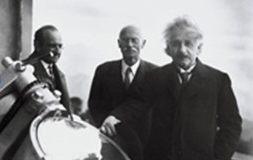- 1610: Galileo
- 1676: Ole Rømer
- 1687: Isaac Newton
- 1781: William Herschel
- 1838: Friedrich Bessel
- 1861: William and Margaret Huggins
- 1912: Henrietta Leavitt
- 1917 Einstein
- 1920: Harlow Shapley
- 1929 Edwin Hubble
- 1948: Ralph Alpher
- 1949: Fred Hoyle
- 1963: Maarten Schmidt
- 1964: Arno Penzias and Robert Wilson
- 1978: Vera Rubin and Kent Ford
- 1989: Margaret Geller and John Huchra
- 1992: John Mather and George Smoot
- 1995: Robert Williams
- 1998: Saul Perlmutter and Brian Schmidt
- 2010: Wendy Freedman
1917: Albert Einstein Invents the Cosmological Constant
 |
| Einstein visiting Mt. Wilson Observatory in 1931. Image courtesy of The Observatories of the Carnegie Institution for Science. |
Albert Einstein is widely celebrated as one of the most brilliant scientists who ever lived. His fame was due to his original and creative theories that at first seemed crazy, but that later turned out to represent the actual physical world. Nonetheless, when he applied his theory of general relativity to the universe as a whole in a paper published in 1917, while serving as Director of the Kaiser Wilhelm Institute for Physics and professor at the University of Berlin, Einstein suggested the notion of a "cosmological constant". He discarded this notion when it had been established that the universe was indeed expanding. His contributions to physics made it possible to envision how the universe evolved.
In order to understand Einstein’s contribution to cosmology it is helpful to begin with his theory of gravity. Rather than thinking of gravity as an attractive force between two objects, in the tradition of Isaac Newton, Einstein’s conception was that gravity is a property of massive objects that “bends” space and time around itself. For example, consider the question of why the Moon does not fly off into space, rather than staying in orbit around Earth. Newton would say that gravity is a force acting between the Earth and Moon, holding it in orbit. Einstein would say that the massive Earth “bends” space and time around itself, so that the moon follows the curves created by the massive Earth. His theory was confirmed when he predicted that even starlight would bend when passing near the sun during a solar eclipse.
In 1917 Einstein published a paper in which he applied this theory to all matter in space. His theory led to the conclusion that all the mass in the universe would bend space so much that it should have long ago contracted into a single dense blob. Given that the universe seems pretty well spread out, however, and does not seem to be contracting, Einstein decided to add a “fudge factor,” that acts like “anti-gravity” and prevents the universe from collapsing. He called this idea, which was represented as an additional term in the mathematical equation representing his theory of gravity, the cosmological constant. In other words, Einstein supposed the universe to be static and unchanging, because that is the way it looked to astronomers in 1917.